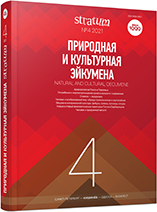Еще раз о бронзовых сосудах из Мутинского могильника (о германских воинах на Сейме и германо-сарматских контактах на рубеже нашей эры)
Bronze Vessels from Mutin Necropolis Reconsidered (on the German Warriors on the Sejm River and German-Sarmatian Contacts on the Eve of the New Era)
Author(s): Mikhail Ju. TreisterSubject(s): History, Archaeology, Military history, Ancient World
Published by: Издательский дом Stratum, Университет «Высшая антропологическая школа»
Keywords: Sejm River; Mutin cemetery; Lower Elbe; Late Republican period; bronze vessels; sutulae; remains of ancient repairs; funerary urns; Germans; Sarmatians; military contacts;
Summary/Abstract: The author attempts to attribute bronze vessels found on the late 1st century BC burial-ground near the village of Mutin on the right bank of the Sejm river in the north-east of the Ukraine. In particular, he offers a detailed discussion on the Beaucaire situla, belonging to a rare type of Late Republican vessels, distributed mainly in the south of France and northern Italy, which in the European Barbaricum, until now, was represented only by a find from the Ehestorf-Vahrendorf cemetery on the Lower Elbe. He studies traces of repairs on the Mutin vessels. These observations make it possible to specify possible origin of the warriors cremated in Mutin, about 2,000 km east of the Lower Saxony. The find in one of the burials of a round-bottomed cauldron with a spherical body is compared with the cauldrons from the Sarmatian burials of the 1st century BC — 1st century AD in the Don region, the interfluve of Don and Volga and the Kuban region. Such cauldrons are unknown either in the Roman Empire or in Germania magna, thus, allowing to suggest that the warrior, who was cremated in the burial-ground on the Sejm river could get it as a result of contacts with the Sarmatians. Other arguments support the hypothesis that the contacts of the Germans with the Sarmatians could have taken place much earlier than previously assumed, in the last decades of the 1st century BC and that such contacts could be mostly in the military context.
Journal: Stratum plus. Археология и культурная антропология
- Issue Year: 2021
- Issue No: 4
- Page Range: 181-202
- Page Count: 22
- Language: Russian
- Content File-PDF

